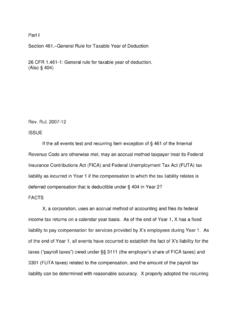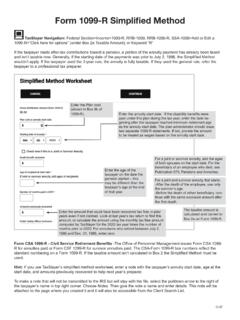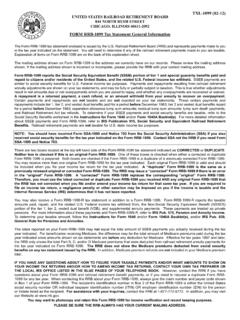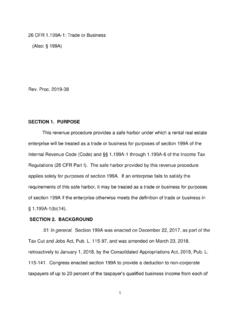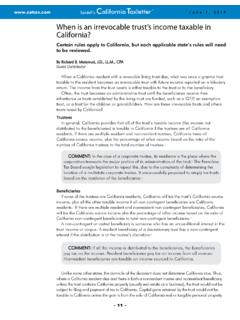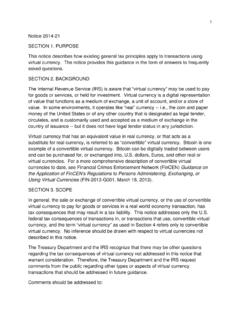Transcription of and Annuities for Pensions General Rule
1 Userid: CPMS chema: tipxLeadpct: 100%Pt. size: 10 Draft Ok to PrintAH XSL/XMLF ileid: .. ons/P939/201312/A/XML/Cycle06/source(Ini t. & Date) _____Page 1 of 83 12:27 - 12-Dec-2013 The type and rule above prints on all proofs including departmental reproduction proofs. MUST be removed before of the TreasuryInternal Revenue ServicePublication 939(Rev. December 2013)Cat. No. 10686 KGeneral Rulefor Pensionsand AnnuitiesGet forms and other Informationfaster and easier byInternet at 's of Periodic in the Under the General To Use Actuarial for Determining Taxable a Ruling on Taxation of Information To Get Tax 's NewBeginning in 2013, distributions from an annuity under a nonqualified plan are considered net investment income for the purpose of figuring the net investment income tax (NIIT).
2 For more information, see the instructions for Form 8960, Net Investment Income Tax Individuals, Estates and the latest information about developments related to Publication 939, such as legislation enacted after it was published, go to publication gives you the information you need to de-termine the tax treatment of your pension and annuity in-come under the General Rule. Generally, each of your monthly annuity payments is made up of two parts: the tax-free part that is a return of your net cost, and the taxa-ble is the General Rule. The General Rule is one of the two methods used to figure the tax-free part of each annuity payment based on the ratio of your investment in the contract to the total expected return.
3 The other method is the Simplified Method, which is discussed in Publication 575, Pension and Annuity must use the General Rule. Use this publication if you receive pension or annuity payments from:Dec 12, 2013 Page 2 of 83 Fileid: .. ons/P939/201312/A/XML/Cycle06/source12:2 7 - 12-Dec-2013 The type and rule above prints on all proofs including departmental reproduction proofs. MUST be removed before nonqualified plan (for example, a private annuity, a purchased commercial annuity, or a nonqualified employee plan), qualified plan if: annuity starting date is before November 19, 1996 (and after July 1, 1986), and you do not qualify to use, or did not choose to use, the Simpli-fied Method, annuity starting date is after November 18, 1996, and as of that date you are age 75 or over and the annuity payments are guaranteed for at least 5 your annuity starting date was between July 1, 1986 and November 19, 1996, you were able to elect to use the Simplified Method or the General Rule.
4 This choice is irrevocable and applied to all later an nuity following are qualified plans. A qualified employee qualified employee tax-sheltered annuity (TSA) plan or Method. If you receive pension or annuity payments from a qualified plan and you are not required to use the General Rule, you must use the Simplified Method to determine the tax-free part of each annuity pay-ment. This method is described in Publication 575, Pen-sion and Annuity , if, at the time the annuity payments began, you were at least age 75 and were entitled to annuity pay-ments from a qualified plan with fewer than 5 years of guaranteed payments, you must use the Simplified in 2013, distributions from an annuity under a nonqualified plan are considered net in vestment income for the purpose of figuring the net investment income tax (NIIT).
5 For more information, see the instructions for Form 8960, Net Investment In come Tax Individuals, Estates and not covered in this publication. Certain topics related to Pensions and Annuities are not covered in this publication. They include:Simplified Method. This method is covered in Publi-cation 575. That publication also covers nonperiodic payments (amounts not received as an annuity) from a qualified pension or annuity plan, rollovers, special averaging and capital gain treatment of lump-sum dis-tributions, and special additional taxes on early distri-butions, excess distributions, and excess accumula-tions (not making required minimum distributions).
6 Individual retirement arrangements (IRAs). Infor-mation on the tax treatment of amounts you receive from an IRA is included in Publication 590, Individual Retirement Arrangements (IRAs).TIPCAUTION!Life insurance payments. If you receive life insur-ance payments because of the death of the insured person, get Publication 525, Taxable and Nontaxable Income, for information on the tax treatment of the from IRS. If, after reading this publication, you need help to figure the taxable part of your pension or annuity, the IRS can do it for you for a fee. For information on this service, see Requesting a Ruling on Taxation of Annuity, and suggestions.
7 We welcome your com-ments about this publication and your suggestions for fu-ture can write to us at the following address:Internal Revenue ServiceTax Forms and Publications Division1111 Constitution Ave. NW, IR-6526 Washington, DC 20224We respond to many letters by telephone. Therefore, it would be helpful if you would include your daytime phone number, including the area code, in your can send your comments from Click on More Information and then on Comment on Tax Forms and Publications .Although we cannot respond individually to each com-ment received, we do appreciate your feedback and will consider your comments as we revise our tax forms and publications.
8 Visit to download forms and publications, call 1-800-TAX-FORM (1-800-829-3676), or write to the ad-dress below and receive a response within 10 days after your request is Revenue Service1201 N. Mitsubishi MotorwayBloomington, IL 61705-6613 Tax questions. If you have a tax question, check the information available on or call 1-800-829-1040. We cannot answer tax questions sent to either of the above ItemsYou may want to see:PublicationCredit for the Elderly or the DisabledTaxable and Nontaxable IncomeTax-Sheltered Annuity Plans (403(b) Plans)Pension and Annuity IncomeIndividual Retirement Arrangements (IRAs)Tax Guide to Civil Service Retirement BenefitsGuide To Free Tax Services 524 525 571 575 590 721 910 Page 2 Publication 939 (December 2013)Page 3 of 83 Fileid.
9 Ons/P939/201312/A/XML/Cycle06/source12:2 7 - 12-Dec-2013 The type and rule above prints on all proofs including departmental reproduction proofs. MUST be removed before (and Instructions)Distributions From Pensions , Annuities , Retirement or Profit-Sharing Plans, IRAs, Insurance Contracts, How To Get Tax Help near the end of this publication for information about getting these publications and InformationSome of the terms used in this publication are defined in the following pension is generally a series of payments made to you after you retire from work. Pension payments are made regularly and are for past services with an annuity is a series of payments under a contract.
10 You can buy the contract alone or you can buy it with the help of your employer. Annuity payments are made regularly for more than one full Distributions from Pensions and Annuities follow the same rules as outlined in this publication unless other-wise of Pensions and Annuities . Particular types of Pensions and Annuities period receive definite amounts at regular intervals for a definite length of for a single life. You receive definite amounts at regular intervals for life. The payments end at and survivor first annuitant re-ceives a definite amount at regular intervals for life.










